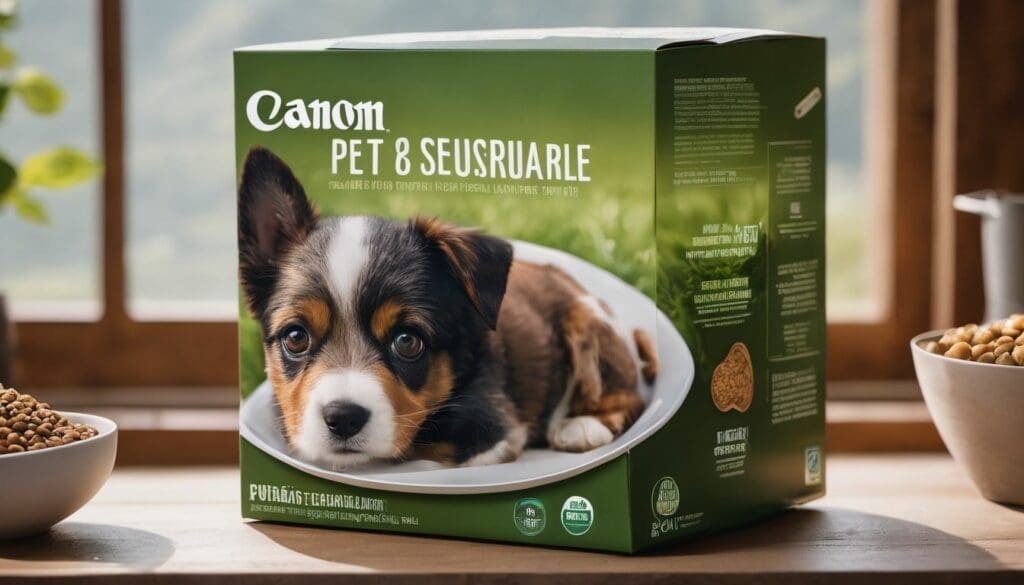As pet owners, we love our furry friends but may overlook the impact their food has on our planet. Surprisingly, if pets were a country, their diet would rank fifth in global meat consumption! Our article unpacks the environmental cost of what’s in your pet’s bowl and offers practical steps to reduce it.
Discover how choosing wisely can help you tread lightly on the earth.
Key Takeaways
- Meat production for pet food generates substantial emissions and waste, with livestock raising contributing to methane release and potential water contamination. Efficiently managing by-products from these processes can lead to more sustainable pet food production.
- The type of pet food impacts its environmental footprint, with dry food typically having a lower carbon footprint than wet due to differences in production energy needs, packaging materials, transportation weight, shelf life stability, and water usage.
- Choosing eco-friendly pet food brands involves looking for those using sustainably sourced ingredients and recyclable or biodegradable packaging to minimise waste. Additionally, selecting alternative protein sources like plant-based or insect-derived proteins can further reduce the environmental impact of pets’ diets.
- Measuring the environmental impact through life cycle assessments helps identify areas within the pet food industry where improvements are necessary; this includes sourcing methods that prioritise local suppliers and organic products which aid in lowering greenhouse gas emissions throughout the supply chain.
- Responsible disposal and management of pet waste are vital in curbing pollution caused by conventional waste management methods. Utilising biodegradable bags and proper composting techniques can significantly decrease the adverse effects on our planet resulting from pet ownership.
The Environmental Impact of Pet Food Production
The production of pet food contributes to carbon emissions and waste, particularly from meat production. Byproducts play a role in sustainability, while the type of pet food (wet or dry) also affects its carbon footprint.
Emissions and waste from meat production
Meat production for pet food creates significant emissions, contributing to the environmental footprint of our furry friends’ diets. Raising livestock generates methane, a potent greenhouse gas with a substantial climate impact.
As animals grow, they produce manure that releases harmful gases and can contaminate water sources if not managed properly.
Additionally, slaughterhouses and meat processing facilities add to the problem by generating waste products that often end up in landfills. Energy-intensive practices in these operations further escalate carbon emissions from pet food production, making sustainability an urgent concern for environmentally conscious pet owners committed to conservation.
The role of byproducts in sustainability
To reduce waste and promote sustainability in pet food production, by-products from meat processing are repurposed. By utilising these by-products, the environmental impact of pet food production is lessened through efficient use of resources.
Repurposing animal by-products also aligns with sustainable agricultural practices, reducing overall waste while ensuring that all parts of animals used for pet food are utilised.
By using by-products from meat production, the demand for virgin materials is reduced and the ecological footprint is minimised. This approach supports a circular economy where resources are reused rather than discarded, contributing to overall environmental sustainability in pet food production.
The carbon footprint of wet food vs dry food
The carbon footprint of pet food varies notably between wet and dry varieties. Below is a table that explores the differences:
| Aspect | Wet Food | Dry Food |
|---|---|---|
| Production Energy | Higher due to the need for refrigeration and energy-intensive canning processes. | Lower as it often requires less processing and energy in production. |
| Transportation | Generates more emissions as it is heavier and bulkier, leading to increased fuel use. | Easier to transport due to lighter weight, reducing the carbon emissions associated with shipping. |
| Packaging | Packaging materials can be less sustainable, as cans and pouches are often not fully recyclable. | Often packaged in bags that can be made from more easily recyclable materials. |
| Shelf Life | Typically has a longer shelf life, which can reduce food waste but may not offset the higher production costs. | Has a long shelf life, which minimises waste without the need for energy-intensive preservation. |
| Water Usage | Requires more water in its composition, contributing to a larger environmental footprint. | Uses less water in its formulation, which is beneficial in regions where water conservation is critical. |
Dry food tends to have a lower carbon footprint than wet food, making it a more sustainable option for eco-conscious pet owners. However, each pet’s dietary needs vary and should be considered when making food choices.
Factors Affecting the Sustainability of Pet Food Production
The sustainability of pet food production is influenced by factors such as the nutritional composition of ingredients, the selection of raw materials, packaging specifications, and transportation and distribution channels.
Each of these aspects plays a crucial role in reducing the environmental impact of pet food production.
Nutritional composition of ingredients
Pet food production’s sustainability begins with the nutritional composition of its ingredients. Choosing high-quality, nutritious ingredients is crucial in reducing the environmental impact of pet food.
The careful selection of plant-based and alternative protein sources contributes to sustainable agriculture and minimises greenhouse gas emissions from animal agriculture. Opting for sustainably sourced ingredients supports eco-friendly pet food choices and reduces the ecological impact of pet diets on climate change.
The nutritional composition of pet food ingredients directly influences the environmental footprint of pet ownership. Sustainable pet products incorporate nutrient-rich components, enabling environmentally conscious individuals to make responsible choices for their pets while supporting conservation efforts.
Raw material selection
When selecting raw materials for pet food, consider the environmental impact of their production. Look for sustainably sourced ingredients that contribute to a lower carbon footprint and reduced land use.
Opting for eco-friendly protein sources like plant-based proteins or insect-based ingredients can also minimise greenhouse gas emissions and support sustainable pet food choices.
Evaluate the nutritional composition of the raw materials to ensure they meet your pet’s dietary needs while being environmentally friendly. Carefully chosen packaging specifications and transportation methods can further enhance the sustainability of pet food production, reducing its overall environmental impact.
Packaging specifications
Pet food packaging specifications play a critical role in environmental sustainability. Using recyclable and biodegradable materials for pet food packs reduces landfill waste and lessens the overall carbon footprint of the product.
Sustainable packaging also helps to preserve natural resources, promoting eco-friendly practices in the pet food industry.
Considering the keywords “environmental impact of pet ownership” and “greenhouse gas emissions from pet diets,” it’s crucial for consumers to choose brands that prioritise sustainable packaging options.
Transportation and distribution channels
Pet food distribution channels play a crucial role in the overall environmental impact of pet food production. Efficient transportation and distribution help reduce greenhouse gas emissions by minimising fuel consumption and optimising routes.
Eco-conscious pet food manufacturers prioritise sustainable packaging materials that are lightweight, durable, and easy to transport, further reducing the carbon footprint associated with transportation.
Sustainable practices within transportation and distribution channels include utilising hybrid or electric vehicles, implementing route optimisation technologies, and partnering with logistics companies committed to eco-friendly operations.
Measuring the Environmental Impact of Pet Food Production
Measuring the environmental impact of pet food production involves conducting life cycle assessments and carbon footprint analyses to identify areas for improvement. Sustainable sourcing methods are also essential in reducing the overall impact on the environment.
Life cycle assessment
Pet food production involves various processes from sourcing raw materials to manufacturing, packaging, and distribution. Life cycle assessment helps in evaluating the environmental impacts of these activities.
This analysis considers factors like resource consumption, emissions, waste generation and energy use across the entire life cycle of pet food products. It provides valuable insights into the carbon footprint, water footprint and other environmental metrics associated with different types of pet food.
Sustainable sourcing methods can play a pivotal role in reducing the environmental impact of pet food production. By considering the full life cycle assessment findings when selecting ingredients and designing packaging specifications, manufacturers can make significant strides towards promoting eco-friendly options for environmentally conscious individuals concerned about their pets’ nutrition and its impact on our planet’s wellbeing.
Carbon footprint analysis
Pet food production’s carbon footprint analysis considers the environmental impact of the entire production process. It measures greenhouse gas emissions, energy consumption, and waste generation from raw material extraction to final product delivery.
Analysing this helps identify areas for improvement in sustainability practices.
Understanding the carbon footprint of pet food is crucial for making informed decisions about eco-friendly pet nutrition. By evaluating the environmental impact at every stage of production, consumers can choose products with lower emissions and contribute to a healthier planet.
Sustainable sourcing methods
Transitioning from carbon footprint analysis, sustainable sourcing methods ensure minimising environmental impact. Selecting locally sourced ingredients reduces transportation emissions. Using organic ingredients helps to reduce chemical pollution and support biodiversity. By choosing suppliers committed to sustainable farming practices, the overall environmental impact is lowered. Considering ethical treatment of animals in the sourcing process promotes sustainability. Ensuring transparency and traceability in the supply chain aids in making informed eco-friendly choices.
Efforts to Promote Sustainable Pet Food Consumption
– Selecting eco-friendly pet food brands is crucial for reducing the environmental impact of pet food production.
– Alternative protein sources and proper management of pet waste are important steps in promoting sustainable choices in pet ownership.
Choosing eco-friendly pet food brands
When selecting pet food, look for eco-friendly brands that prioritise sustainability and ethical sourcing.
- Look for brands that use locally sourced and sustainable ingredients to reduce the environmental impact of transportation and support local farmers.
- Consider pet food brands that employ eco – friendly packaging such as recyclable or biodegradable materials to minimise waste.
- Choose companies that are committed to transparency about their ingredient sources, production processes, and environmental initiatives.
- Opt for pet food brands that prioritise ethical animal welfare practices and use responsibly sourced proteins to reduce the environmental impact of meat production.
- Consider supporting pet food companies that invest in sustainable farming practices or support conservation efforts to offset their environmental footprint.
- Explore options for plant-based or insect-based protein pet foods as alternative, eco-friendly sources of nutrition for your pets.
Alternative protein sources
Pet food production can benefit from alternative protein sources. These sources include plant-based proteins such as soy, lentils, and peas. Insects like crickets and mealworms are also emerging as sustainable protein options due to their low environmental impact. Another alternative is cultured or lab-grown meat, which could potentially reduce the environmental burden of traditional meat production. Additionally, single-celled proteins derived from microorganisms like algae and fungi hold promise for sustainable pet food production. The exploration of these alternative protein sources signifies a shift towards more environmentally friendly pet food options.
Proper management of pet waste
- Utilise biodegradable bags for cleaning up pet waste to minimise plastic pollution.
- Compost pet waste in a designated area, following safe and proper guidelines for composting animal waste.
- Avoid flushing pet waste down the toilet as it can contribute to water pollution.
- Consider installing a septic system designed for disposing of pet waste if viable and appropriate for your property.
- Encourage the use of sustainable cat litter made from natural materials such as corn, paper, or wood chips.
Eco-conscious pet supply choices
Choosing eco-friendly pet supplies can significantly reduce the environmental impact of pet ownership. Consider the following choices:
- Eco – friendly pet toys made from sustainable materials such as hemp, organic cotton, or recycled rubber.
- Biodegradable waste bags for proper disposal of pet waste, reducing plastic pollution.
- Sustainable and non – toxic grooming products to minimise chemical runoff into water systems.
- Recycled or upcycled pet beds and furniture to decrease the demand for new materials and reduce waste.
- Renewable and natural fibre – based collars, leashes, and harnesses in place of synthetic materials.
- Energy-efficient and low-impact litter for cats, contributing to a smaller carbon footprint.
- Environmentally friendly food and water dishes made from bamboo, stainless steel, or ceramic that are durable and reusable.
Conclusion: The Importance of Making Sustainable Choices in Pet Ownership.
In conclusion, pet food production has a significant environmental impact. Consider the emissions and waste from meat production as well as the carbon footprint of wet versus dry food.
When choosing pet food, be mindful of factors that affect sustainability such as nutritional composition, raw material selection, packaging specifications, and transportation. Efforts to promote sustainable pet food consumption are crucial for reducing the environmental footprint of pet ownership.
FAQs
1. What is the environmental impact of pet food production?
The impact includes greenhouse gases from creating pet diets contributing to climate change, and measures the environmental footprint of producing animal nutrition.
2. Do eco-friendly pet food options exist to reduce this impact?
Yes, there are eco-friendly pet food options that aim to lessen emissions and offer more sustainable choices for your pets’ diet.
3. How does pet food contribute to greenhouse gas emissions?
Pet food production involves processing and transporting ingredients which release greenhouse gases into our atmosphere, adding to global warming.
4. Can we make changes in our pets’ diets for better environmental considerations?
Absolutely, by choosing environmentally considerate foods we can help lower the overall carbon footprint associated with feeding our beloved animals.





